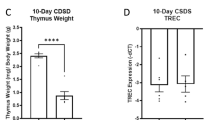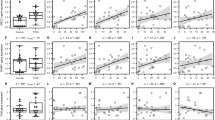Abstract
This research assessed differences in DNA repair in lymphocytes from high-and low-distressed individuals. A median split on Minnesota Multiphasic Personality Inventory (MMPI) Scale 2 divided 28 newly admitted nonpsychotic psychiatric inpatients into high- and low-distress subgroups. The high-distress subgroup had significantly poorer DNA repair in lymphocytes exposed to X-irradiation than low-distress subjects. We also found that lymphocytes obtained from this psychiatric sample had significantly poorer DNA repair than lymphocytes from nonpsychiatric control subjects when compared 5 hr after X-irradiation. A high level of distress therefore appears to be associated with significant dysfunctional differences at the molecular level which may have important implications for health. These data provide evidence for a direct pathway through which distress could influence the incidence of cancer.
Similar content being viewed by others
References
Aarstad, H. J., Gaudernack, G., and Seljelid, R. (1983). Stress causes reduced NK activity in mice.Scand. J. Immunol. 18: 461–464.
Ader, R. (1980). Psychosomatic and psychoimmunologic research.Psychosom. Med. 42: 307–321.
Akrigg, A., and Cook, P. R. (1980). DNA gyrase stimulates transcription.Nucleic Acids Res. 8: 845–854.
Bartrop, R. W., Luckhurst, E., Lazarus, L., Kiloh, L. G., and Penny, R. (1977). Depressed lymphocyte function after bereavement.Lancet 1: 834–836.
Cook, P. R., and Brazell, I. A. (1976). Detection and repair of single-strand breaks in nuclear DNA.Nature 263: 679–682.
Fox, B. H. (1978). Cancer death risk in hospitalized mental patients.Science 201: 966–967.
Fox, B. H. (1981). Psychosocial factors and the immune system in human cancer. In Ader, R. (ed.),Psychoneuroimmunology, Academic Press, New York.
Glaser, R., Kiecolt-Glaser, J. K., Speicher, C. E., and Holliday, J. E. (1985). Stress, loneliness, and changes in herpesvirus latency.J. Behav. Med. 8: 249–260.
Hart, R. W., Hall, K. Y., and Daniel, F. B. (1978). DNA repair and mutagenesis in mammalian cells.Photochem. Photobiol. 28: 131–138.
Herberman, R. B. (1982). Possible effects of central nervous system on natural killer (NK) cell activity. In Levy, S. M. (ed.),Biological Mediators of Health and Disease: Neoplasia, Elsevier, New York.
Jemmott, J. B., III, Borysenko, J. Z., Borysenko, M., McClelland, D. C., Chapman, R., Meyer, D., and Benson, H. (1983). Academic stress, power motivation, and decrease in secretion rate of salivary secretory immunoglobulin A.Lancet 1: 1400–1402.
Kiecolt-Glaser, J. K., Garner, W., Speicher, C. E., Penn, G. M., Holliday, J. E., and Glaser, R. (1984a). Psychosocial modifiers of immunocompetence in medical students.Psychosom. Med. 46: 7–14.
Kiecolt-Glaser, J. K., Ricker, D., Messick, G., Speicher, C. E., Garner, W., and Glaser, R. (1984b). Urinary cortisol, cellular immunocompetency, and loneliness in psychiatric in-patients.Psychosom. Med. 46: 15–24.
Kiecolt-Glaser, J. K., Speicher, C. E., Holliday, J. E., and Glaser, R. (1984c). Stress and the transformation of lymphocytes by Epstein-Barr virus.J. Behav. Med. 7: 1–12.
Laudenslager, M. L., Ryan, S. M., Drugan, R. C., Hyson, R. L., and Maier, S. F. (1983). Coping and immunosuppression: Inescapable but not escapable shock suppresses lymphocyte proliferation.Science 221: 568–570.
Lipetz, P. D., Galsky, A. G., and Stephens, R. E. (1982a). Relationship of DNA tertiary and quaternary structure to carcinogenic processes.Adv. Cancer Res. 36: 165–210.
Lipetz, P. D., Brash, D. E., Joseph, L. B., Jewett, H. D., Lisle, D. R., Lantry, L. E., Hart, R. W., and Stephens, R. E. (1982b). Determination of DNA superhelicity and extremely low levels of DNA strand breaks in low numbers of nonradiolabeled cells by DNA-4′,6-dianidino-2-phenylindole fluorescence in nucleoid gradients.Anal. Biochem. 121: 339–348.
Miller, E. C. (1978). Some current perspective on chemical carcinogenesis in humans and experimental animals: Presidential address.Cancer Res. 38: 1479–1496.
Monjan, A. A. (1981). Stress and immunologie competence: Studies in animals. In Ader, R. (ed.),Psychoneuroimmunology, Academic Press, New York.
Palmbald, J. (1981). Stress and immunologic competence: Studies in man. In Ader, R. (ed.),Psychoneuroimmunology, Academic Press, New York.
Pero, R. W., Bryngelsson, C., Mitelman, F., Thulin, T., and Norden, A. (1976). High blood pressure related to carcinogen-induced unscheduled DNA synthesis, DNA carcinogen binding, and chromosome aberrations in human lymphocytes.Proc. Natl. Acad. Sci. (USA) 73: 2496–2500.
Setlow, R. B. (1978). Repair deficient human disorders and cancer.Nature (Lond.) 271: 713–717.
Shavit, Y., Lewis, J. W., Terman, G. W., Gale, R. P., and Liebeskind, J. C. (1984). Opoid peptides mediate the suppressive effect of stress on natural killer cell activity.Science 223: 188–223.
Shekelle, R. B., Raynor, W. J., Ostfeld, A. M., Garron, D. C., Bieliauskas, L., Liu, S. C., Maliza, C., and Paul, O. (1981). Psychological depression and 17 year risk of death from cancer.Psychosom. Med. 43: 117–125.
Stephens, R. E., and Lipetz, P. D. (1985). In FIBER Foundation (ed.),Biomarkers in Aging, Alan R. Liss, New York.
Takabe, H., Yagi, T., and Satoh, Y. (1983). Cancer-prone hereditary diseases in relation to DNA repair. In Mirand, E. A., Hutchinson, W. B., and Mihich, E. (eds.),International Cancer Congress, Part B. Biology of Cancer (1), Alan R. Liss, New York.
Waller, R., and Duncan, D. B. (1969). A Bayes rule for the symmetric multiple comparisons problem.Am. Stat. Assoc. 64: 1483–1503.
Webb, J. T., McNamara, K. M., and Rodgers, D. A. (1981).Configural Interpretations of the MMPI and CPI. Ohio Psychology Publishing, Columbus.
Author information
Authors and Affiliations
Additional information
This research was funded in part by General Molecular Applications, Inc., the Bremer Foundation, the Samuel J. Roessler Fund, and Comprehensive Cancer Center Core Grant CA-16068-09.
Rights and permissions
About this article
Cite this article
Kiecolt-Glaser, J.K., Stephens, R.E., Lipetz, P.D. et al. Distress and DNA repair in human lymphocytes. J Behav Med 8, 311–320 (1985). https://doi.org/10.1007/BF00848366
Accepted:
Issue Date:
DOI: https://doi.org/10.1007/BF00848366




